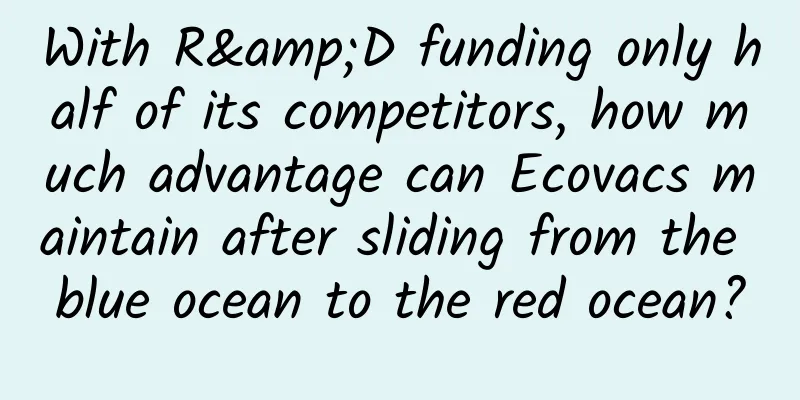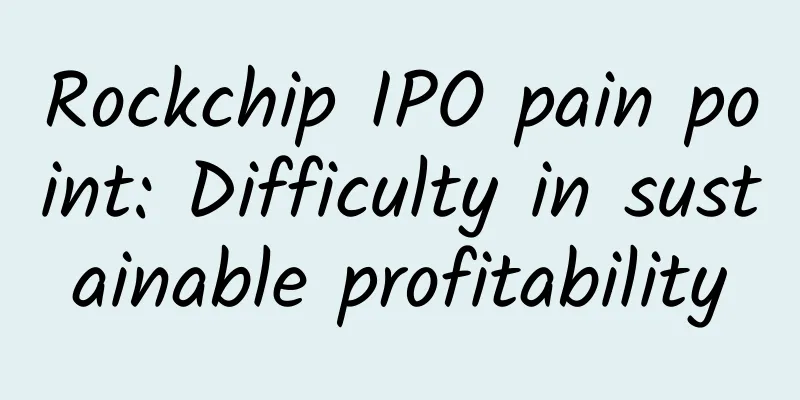With R&D funding only half of its competitors, how much advantage can Ecovacs maintain after sliding from the blue ocean to the red ocean?

|
Since July, Ecovacs' stock price has been falling all the way, hitting the daily limit several times in a row, and has now fallen to about 146 yuan per share, with its market value falling by nearly half from its peak. As the leader in the current domestic sweeping robot segment, does Ecovacs' Waterloo have any metaphors? Is there too much bubble in the capital market for sweeping robots, or is it just an IQ tax as many "anti-robot" consumers believe? When we search for "sweeping robot" on Xiaohongshu, we can see more than 60,000 notes, including product reviews of different brands, sharing of various usage tips, and even a lot of jokes. From this, we can see that this track worth hundreds of billions of yuan has indeed attracted a lot of attention. From Taiyikai to Ecovacs In 1988, Suzhou Taiyikai Electric Appliances was a company that focused on OEM for foreign brands such as Philips and Panasonic, and its main business was vacuum cleaners. During the OEM process, Taiyikai continued to accumulate R&D experience and produced small household appliances such as vacuum cleaners and dust mite removers; In 2006, the boss Qian Dongqi was not satisfied with being a behind-the-scenes outsourcing company for mature companies in Europe, the United States, Japan and other countries. Based on years of accumulated OEM experience, he founded "Ecovacs" and began branded independent production, mainly engaged in sweeping robots and vacuum cleaners. In 2011, when domestic sweeping robots were just emerging, Qian Dongqi was optimistic about the blue ocean market of smart sweeping robots. In order to focus on the development of household cleaning robot products, Qian Dongqi once again made an unexpected decision - decisively cutting off the vacuum cleaner business. In 2021, according to Ecovacs' semi-annual financial report, its revenue in the first half of the year reached 5.359 billion yuan, and its net profit income was 850 million yuan, a year-on-year increase of 543%. Whether it is online sales channels or offline, Ecovacs has firmly held the position of sales champion. After years of deep cultivation in the industry, Ecovacs has formed a relatively comprehensive first-mover advantage in technology, brand, channels, etc., and the moat effect is obvious. Although the product line is complete, covering all the overall planning models from entry-level products to high-end flagships, it can be clearly seen that compared with cost-effective home appliance manufacturers represented by Xiaomi, Ecovacs' products are more concentrated in the high-end product line: in the 2,000-3,000 yuan price segment, Ecovacs' market share is as high as 53%, and the price segment above 3,000 yuan accounts for 31.5%. The post-90s generation has accelerated the market for "sweeping robots" As early as 2002, sweeping robots were already on the market, first developed by industry giant iRobot in the United States. This was a sweeping robot that was able to step out of the laboratory and truly realize commercial value. At the time, it was priced at nearly US$200. However, due to the limitations of the technology at that time, the sweeping robots at that time still adopted a random collision cleaning mode, which often caused problems such as jamming, missed sweeps, repeated sweeps, and poor cleaning strength, resulting in low efficiency and poor experience. Therefore, most of the buyers at that time were high-tech product enthusiasts. With the maturity of technology and supply chain, sweeping robots have gradually acquired the ability of global planning, that is, first building a map and then planning the cleaning route, which greatly improves cleaning efficiency. In 2016, Xiaomi and Roborock Technology launched the "Mijia Sweeping Robot", priced at 1,699 yuan. The improvement in efficiency and reduction in cost allowed sweeping robots to truly enter households and become an indispensable member of the smart home environment. Ecovacs is not the first to make sweeping robots, nor will it be the last, but at least it currently has the highest market share. Although this is inseparable from the strategy and courage of the founder, it must be mentioned that the business opportunities created by market demand have allowed Ecovacs to seize the opportunity at the right time. In 2020, affected by the epidemic, the stay-at-home economy and the surge in demand for household cleaning led to a surge in sales of cleaning appliances. According to data from CMM, the online sales share of sweeping robots increased by 24.1% year-on-year in 2020. Leading brands represented by Ecovacs also achieved breakthroughs in consumer pain points at this time. With the iteration and update of technology, problems such as obstacle avoidance and mopping began to be solved. The change in consumer groups is also a driving force behind the strong demand for sweeping robots. As people born in the 1980s and 1990s gradually replaced those born in the 1950s and 1960s to become the main force of household consumption and housework, the main target customer groups began to accept various smart home appliances on a large scale. Busy work, willing to spend money to buy time, happy to try new things, and highly receptive to high-tech products are all notable characteristics of the young consumer group. As sweeping is a "must-have option at home", sweeping robots are obviously a good solution to this problem. On the other hand, from the supply side, the commercialization of technologies such as artificial intelligence, the Internet of Things, and cloud computing have made smart appliances truly "smart." Generally speaking, the intelligent system of a sweeping robot consists of four parts: navigation system, cleaning system, battery life system and interaction system. Basically, all major manufacturers are carrying out technical upgrades for the navigation system and cleaning system. In terms of navigation, the current mainstream sweeping robot models have been upgraded from random collision to global planning. The cleaning system has been upgraded in terms of suction, sweeping and mopping, self-cleaning, dust recognition and other aspects. The implementation of technology makes the product more mature and intelligent, while also making it possible to reduce costs. The field of sweeping robots is attracting more participants. The blue ocean turns into a red ocean. How long can Ecovacs maintain its advantage? According to data from Aowei Cloud Network, the current penetration rate of sweeping robots in my country is between 5% and 6%, while as early as 2019, the penetration rate of sweeping robots in American households had reached 12%-13%. With increasingly mature technology, lower costs and a promising market, the sweeping robot market is becoming increasingly crowded. Judging from the current domestic market structure of sweeping robots, the industry concentration is still very high, but Ecovacs is not sitting back and relaxing. Xiaomi and Roborock Technology, which are in the second echelon, have quietly seized 25% of the market share, and Roborock Technology is a strong competitor of Ecovacs in the mid-to-high-end product line. Overseas veteran sweeping robot brands, represented by iRobot, have small sales due to channel reasons, but they have their own high technical barriers and are far ahead in overseas market share. In addition, some industry dark horses such as Yunjing often emerge. Faced with such a situation, Ecovacs has been actively developing its domestic market on the one hand, and conquering overseas markets on the other. Ecovacs' overseas business revenue achieved a year-on-year growth of 134.8% in the first half of 2021. The boss Qian Dongqi started a second business, handed Ecovacs over to his son, and created his own sub-brand Tineco, which also achieved a year-on-year growth of 452.8% in overseas business revenue. Although the growth rate is encouraging, the absolute value is still not impressive. Industry giant iRobot is far ahead in global sales, and Ecovacs still cannot catch up. For Ecovacs, which focuses on "high-end intelligence", establishing higher technical barriers is an urgent problem to be solved. In the field of household cleaning smart robots, consumer demand is still a long way from being fully met. To be truly intelligent, products need to comprehensively use new technologies such as the Internet of Things and artificial intelligence. Under the cost constraints of large-scale mass production, it is difficult for most robots to accurately identify obstacles and accurately plan routes. At present, the overall R&D level of sweeping robots in the market is still relatively low. Although Ecovacs is currently leading in market share, there is still room for improvement in R&D investment. In 2020, Ecovacs' R&D investment accounted for 4.67% of its total revenue, while its competitor iRobot reached 11%, more than twice as much. Moreover, the ancient product of household vacuum cleaner is also constantly improving. Because of its unparalleled advantage of "precision", in the foreseeable future, fine cleaning will still be a territory that sweeping robots cannot enter. In addition, manufacturers also need to accurately identify and meet the diverse needs of consumers: from simply sweeping the floor to competing to see who can sweep the floor cleaner, to competing to see who can accurately locate the route and identify obstacles, and then to competing to see who can mop the floor cleaner in the era of sweeping and mopping. In the era of artificial intelligence, they may also compare product human-computer interaction experience and family customization needs. These are all needs that need to be explored and even created by manufacturers. In this long technological "marathon", who will truly become the "leader" of the industry in the future will certainly not be determined by a market value that fluctuates between hundreds of billions or billions. Technology is the fundamental force that determines the ownership of this long-distance championship. Now, it may be time for Ecovacs, which looks up to overseas, to pay attention to its feet, increase investment in research and development, and maintain sufficient and long-term technological competitiveness, which is the basic rule for the brand's evergreenness. As a winner of Toutiao's Qingyun Plan and Baijiahao's Bai+ Plan, the 2019 Baidu Digital Author of the Year, the Baijiahao's Most Popular Author in the Technology Field, the 2019 Sogou Technology and Culture Author, and the 2021 Baijiahao Quarterly Influential Creator, he has won many awards, including the 2013 Sohu Best Industry Media Person, the 2015 China New Media Entrepreneurship Competition Beijing Third Place, the 2015 Guangmang Experience Award, the 2015 China New Media Entrepreneurship Competition Finals Third Place, and the 2018 Baidu Dynamic Annual Powerful Celebrity. |
<<: Deloitte: Renewable Energy Industry Outlook 2023
>>: 4 reasons why Microsoft Surface is doomed
Recommend
What is the warning of the US fireball incident? The asteroid impact drama will be staged in the second half of the year, don't miss it
Around 8 a.m. local time on April 27, many people...
Didi's rival is here, Daimler and Geely will set up a joint venture for online car-hailing
According to Bloomberg, Geely and Daimler will co...
The beginning of spring and the Lantern Festival are connected, which only happens 6 times in this century!
February 4 and February 5 will usher in the Sprin...
Mimi Meng, Visual Magazine, and other big names will teach you how to come up with titles!
I wonder if you have ever encountered this situat...
VR becomes the protagonist again. What are the new highlights of the 2016 E3 Expo in the United States?
In 2016, the highlight of the global capital mark...
What did Baidu do with its 7 billion research funds?
[[128328]] It is said that this is Baidu's in...
Information APP interface design tips!
As a tool for disseminating art information, art ...
Sharing Experience: Expression, Feedback and Stimulation in Game Design
[[150664]] It is a difficult process from the bir...
Are there auroras on the sun?
Hello everyone, my name is Zhou Xuzhi, from the I...
Linger Investment Research Diary "T+0 Practical Training Camp" including indicators
Ling'er Investment Research Diary "T+0 Pr...
Apple releases iOS 15.0.2: finally fixes many iPhone issues!
[[428321]] After the release of iOS 15, various m...
Where does the held urine go?
Audit expert: Zeng Ling Deputy Chief Physician of...
Hyundai Motor ranks last in terms of R&D investment, and its future development may be further restricted
In a ranking of the proportion of R&D investm...
Asteroids, micrometeors, fireballs...how do we distinguish between similar "stars"?
According to the solar nebula theory, the solar s...









